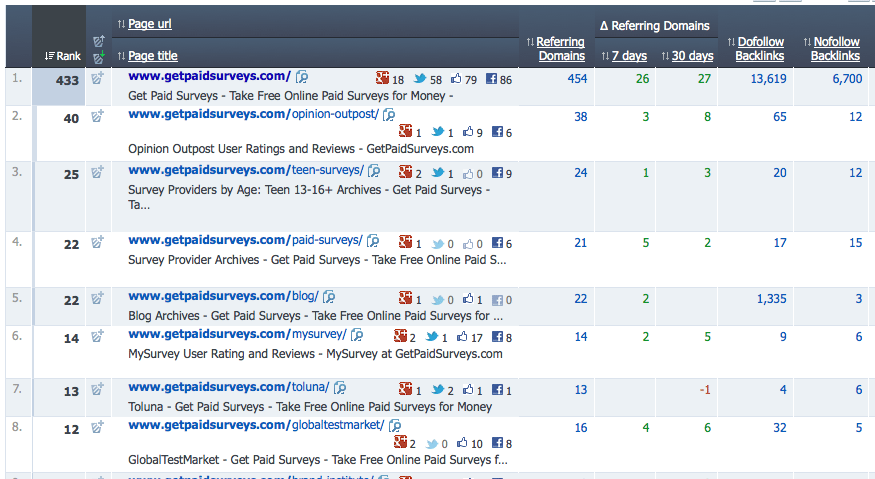Branded & Natural Anchor Text One of the first things I look at when analyzing a link portfolio is the anchor text of the links already acquired. Here, I am looking to see if the backlink portfolio contains a good balance of branded anchor text, natural anchor text, and keyword driven anchor text.
In the first example, you can see that this website is building a lot of exact match keyword anchor text and not a lot of branded or natural anchor text. This could very well be a red flag to the search engines.  In the second example, this website has a lot of branded anchor text, with some partial match, and links with no anchor text at all. This is starting to look more natural.
In the second example, this website has a lot of branded anchor text, with some partial match, and links with no anchor text at all. This is starting to look more natural. 
Links To Deep Pages
The next thing I look at is link distribution across the website. Here I am looking at the number of links coming into the home page vs other pages deeper in the site. It looks very unnatural to have a high percentage of your links pointing at the home page. In the first example, the website has built a high percentage of links to their home page, with very few to the other pages of their website. This could be a red flag to the engines. In the second example, this site has a ton of links going to the home page, but also a high number and good percentage of links going to other pages of their site. This looks more natural to the engines.
In the second example, this site has a ton of links going to the home page, but also a high number and good percentage of links going to other pages of their site. This looks more natural to the engines. 
Linking Root Domains
I also like to look at how many unique root domains are linking to the website. Having 100k links pointing at your site from one domain doesn’t do any good, in fact, can get your penalized or completely removed from the search engine indexes for being classified as a web spammer. I don’t think we need images to get the point across on this one.Links From Unique IP Addresses
Along the same lines as linking root domains, I like to look at the number of domains across unique IP addresses that are linking to the website. Since the search engines look at links as ‘votes’, it would make sense that they would discount a large volume of links all coming from the same IP address since the sites are likely owned by the same person. No need for images on this one either.Links From Trusted Sites
I then like to look for any links coming from highly trusted websites. For this example, I pulled the backlink portfolio of two websites in the SEO industry. In the first example, the only link from a trusted website in the top 30 was Marketing Pilgrim. In the second example, the site has several links from trusted industry websites.
In the second example, the site has several links from trusted industry websites. 
Link Diversity
I also look for different types of links, meaning links coming from blogs, directories, news hubs, etc to see if there is a good distribution across many different types of sites. Just like with the other metrics I’ve covered in this post, too much of one thing is not natural! I don’t think we need an example for this one.No Follow Links
Most SEOs try to game the system and by doing so, they build links that ‘pass the most link juice’. When doing SEO the right way, over time you will secure links that include the no follow attribute. This is natural and something that shouldn’t be avoided. A balanced backlink portfolio includes do follow and no follow links. If the number of nofollow links is dismal or non existent all together, it is a signal to the search engines that something might not be right. No example for this one.Image Links
Lastly, I look to see if any links are coming from images, or if all are coming from text links. Natural link portfolios include image links and text links. At the end of the day, if your backlink profile has a nice balance in each of these areas, you are probably okay and doing things right. You can also ask yourself, if Matt Cutts or Duane Forrester took at look at your link portfolio, would they be suspicious of anything? If so, you’ve got some work cut out for you to clean things up. Do you have any questions or additions to the post? If so, please share in the comments section below.]]>Greg is the founder and CEO of Stryde and a seasoned digital marketer who has worked with thousands of businesses, large and small, to generate more revenue via online marketing strategy and execution. Greg has written hundreds of blog posts as well as spoken at many events about online marketing strategy. You can follow Greg on Twitter and connect with him on LinkedIn.
Greg Shuey
Greg is the founder and CEO of Stryde and a seasoned digital marketer who has worked with thousands of businesses, large and small, to generate more revenue via online marketing strategy and execution. Greg has written hundreds of blog posts as well as spoken at many events about online marketing strategy. You can follow Greg on Twitter and connect with him on LinkedIn.
